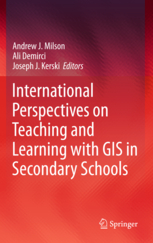 International Perspectives on GIS in Secondary Schools
International Perspectives on GIS in Secondary Schools
.
- Is the first book to capture an international perspective on the status of GIS in schools.
- Included in each chapter at least one author who currently lives and works in the country profiled and can thus provide the most appropriate local perspective on the country.
- Demonstrates that GIS is not only a technological tool to be used in the classroom, but it is also an avenue for motivation, encouragement, and cooperation in understanding and solving global problems.
- Provides many different examples, ideas, and methods of using GIS and GPS in secondary schools from around the world.
- Features inquiry-based learning about current events using real-world data in a problem-solving, technology-driven environment.
This, the first publication to collate a broad international perspective on the pedagogical value of GIS technology in classrooms, offers an unprecedented range of expert views on the subject. Geographic Information Systems (GISs) are now ubiquitous and relatively inexpensive. They have revolutionized the way people explore and understand the world around them. The capability they confer allows us to capture, manage, analyze, and display geographic data in ways that were undreamt of a generation ago. GIS has enabled users to make decisions and solve problems as diverse as designing bus routes, locating new businesses, responding to emergencies, and researching climate change. GIS is also having a major impact in the classroom. Students and teachers around the world are using this significant emerging technology in the secondary school classroom to study social and scientific concepts and processes, to broaden their technical skills, and to engage in problem solving and decision making about local and global issues.
International Perspectives on Teaching and Learning with GIS in Secondary Schools brings together authors from 34 countries who profile the current status of GIS in secondary school teaching and learning in their country. Each chapter includes a summary of the country’s educational context, a case study illustrating how GIS is used in secondary schooling, and an assessment of the opportunities and challenges in teaching and learning with GIS now and in the future. The book demonstrates that GIS is not only a technological tool to be used in the classroom, but also a catalyst for motivation, encouragement, and cooperation in understanding and solving global problems.
Buy “International Perspectives on Teaching and Learning with GIS in Secondary Schools” at Amazon.com or as a Kindle edition on Amazon or from Springer.




